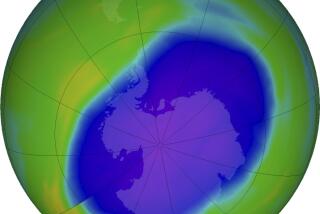Ozone-Depleting Chemicals Down 40%, U.N. Study Says : Environment: Five-year gain may mean substances can be phased out well before the end-of-decade deadline. Strict control of substitutes for CFCs urged.
- Share via
WASHINGTON — Worldwide production and use of the chemicals blamed for depletion of the protective ozone layer in Earth’s stratosphere has declined 40% in the last five years, and the chemicals could be phased out ahead of the schedule set in a landmark international treaty, participants in a United Nations scientific study reported Friday.
The good news came less than a month after participants in the same project disclosed that ozone depletion is now occuring over most of the world and is continuing during the spring and summer over the United States and Europe. The thinning of the ozone layer, which allows increased levels of ultraviolet radiation to reach the Earth, was thought a few years ago to be only a seasonal phenomenon over Antarctica.
But, while concern is growing over the health and environmental impact of increased exposure to ultraviolet radiation, the new report indicates that progress in addressing the threat can be made faster than scientists had earlier predicted.
“Based on elaborate evaluation, we have concluded that it is technically feasible in developed countries to phase out production of CFCs and halons by 1997 or earlier, methyl-chloroform as early as 1995, and carbon tetrachloride in the vast majority of applications by 1995,” Stephen Anderson of the U.S. Environmental Protection Agency told a Senate subcommittee.
CFCs--chlorofluorocarbons--are chlorine-based chemicals that are used as refrigerants and aerosol can propellants. Halons, their chemical cousins, are widely used in firefighting. Other chemicals linked to ozone destruction fall into a variety of categories, including solvents and preservatives.
Under an agreement signed in Montreal in 1987 and updated in 1990, 74 countries have agreed to phase out production and use of the ozone-damaging compounds by the turn of the century.
But evidence that ozone depletion now extends to heavily populated regions in both the Northern and Southern hemispheres has prompted the EPA to raise its projections of skin cancer rates and has focused new attention on possible damage to the body’s immune system.
Anderson’s comments to the Senate Commerce, Science and Transportation subcommittee were made in his role as a panel chairman in the U.N.-sponsored study. He refused to say whether the EPA favors accelerating the CFC phase-out schedule that is contained in the Montreal protocol.
The agreement is to be updated next year. Environmentalists have called for its deadlines to be advanced and for the careful control of chemicals being introduced as CFC substitutes.
The progress in cutting back CFC use, linked with recent reports of increased ultraviolet radiation exposure, is likely to generate new pressure to advance the phase-out timetable.
Sen. Albert Gore Jr. (D-Tenn.), who was chairman of the subcommittee hearing Friday, and others have called on the Bush Administration to implement a section of the 1990 Clean Air Act that calls for acceleration of the phase-out if scientists discover increased hazards in ozone depletion.
Anderson attributed progress toward the phase-out of the destructive chemicals to dramatic reductions in the use of chlorine- and bromine-based solvents and aerosols, dramatic reductions in the use of halons by firefighters and public concern over increased ultraviolet radiation exposure.
More to Read
Sign up for Essential California
The most important California stories and recommendations in your inbox every morning.
You may occasionally receive promotional content from the Los Angeles Times.













